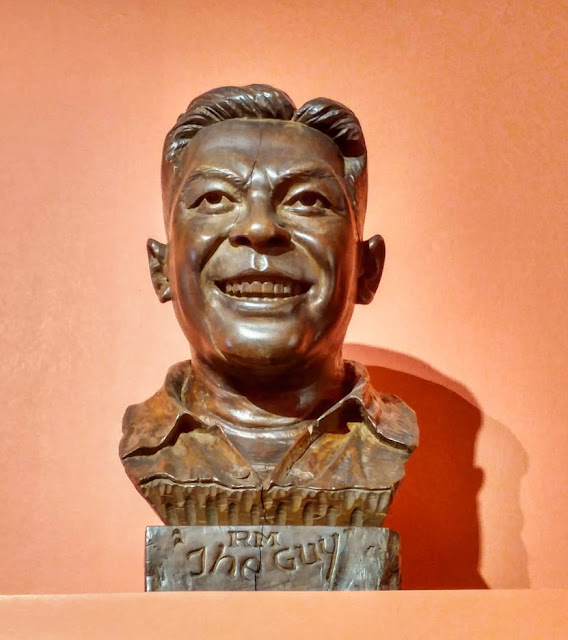When I visited the National Museum of Fine Arts last December, I noticed a new exhibit featuring five sculptures of Cebuano artist Fidel T. Araneta. It was an exciting find since I've never heard of Araneta before seeing the display and it's related to Cebu.
The wooden sculptures were of Philippine Presidents Sergio Osmeña Sr. and Ramon Magsaysay Sr., Lapu-Lapu, U.S. President Dwight Eisenhower, and a sleeping Santo Niño. A few months ago, I've written about Araneta's "Sleepy Santo Niño 400 Years After" which was created in 1965 to commemorate the 400th anniversary of the arrival of Miguel Lopez de Legazpi in Cebu, the beginning of Spanish Colonization, and the finding of the Santo Niño icon (its origin can be traced to the Magellan-El Cano Expedition).
All five sculptures were donated by Araneta to the National Museum. Two of the carved busts won First Prize (Osmeña 1952 and Eisenhower 1953) in the wood carving category by the Art Association of the Philippines.
The Magsaysay, Osmeña, and Eisenhower sculptures are life-like and uncannily accurate. It seems Araneta was able to capture the essence and personality of each of his subjects. When you compare the carvings to actual photos or videos of these presidents, you can see the similarities. Magsaysay and Eisenhower in the 1950s were at the height of their political careers. Both were presidents of their respective countries when Araneta chose them as his muses.
Fidel Araneta was born in Bogo, Cebu in 1911. He attended Cebu High School which is now Abellana National School. Upon the advice of one of his American teachers, he went to Manila and enrolled in the University of the Philippines School of Fine Arts. He had Fernando Amorsolo and Guillermo Tolentino as his professors during his UP years. Due to family circumstances, he wasn't able to complete his studies.
I've wondered what type of wood material did the artist use for these sculptures. While researching about the Cebuano artist, I came across an interview that National Artist and sculptor Napoleon Abueva gave in 2003. It gives us a glimpse of what could have been Araneta's medium for his art.
Abueva in his teens lived in Cebu for two years in the late 1940s to learn about sculpting. He first apprenticed with Imo Ponce and then to Araneta because of his religious works.
"At some point, I became fascinated with religious images and I met Fidel Araneta who specialized in it. Araneta, by the way, was a student of National Artist Guillermo Tolentino at UP."
"My experiences with Ponce and Araneta empowered me to experiment with almost any kind of media—from iron to adobe, from steel to coral. My favorite medium, though, had been Philippine hardwoods: narra, kamagong, ipil, bamboo and molave. Looking back, I think it was good that I experienced handling machinery."
After seeing the Araneta exhibit in the National Museum. I started researching about him. Unfortunately, I wasn't able to find a lot of materials about him. He was a successful commercial sculptor. His atelier was in-demand and well-known. For every religious celebration or holiday, his workshop would be at full capacity churning out spiritual icons (e.g. statues of the Virgin Mary or St. Joseph and baby Jesus). He was also commissioned to create religious figures for various churches in the Visayas and Mindanao.
Araneta was part of the Independent Artists' Guild established by Julian Jumalon in August 22, 1937. It eventually became known as the Cebu Art Association. In 1960, he represented the art of sculpting in the council of Arts of Cebu (the organization will evolve to be the Arts Council of Cebu Foundation, Inc. in 1990).
Another favorite subject of Araneta was Jose Rizal. He sculpted a seated Jose Rizal statue for Cebu Normal University in 1952. His fascination could have been influenced by his School of Fine Arts teacher, Tolentino who used Rizal's works as inspiration for his Oblation statue.
I still have to confirm his other catalog raisonne since little material has been written about him. His artworks include the Christ on the Cross in the Redemptorist Church in Cebu, the Twelve Apostles rendered in multi-colored mosaic tiles in the Archdiocesan Shrine of San Nicolas de Tolentino Parish in Pasil, a Lapu-Lapu statue inside Camp Lapu-Lapu in Lahug, and even the original Oblation statue that used to be in front of the Administration Building in the University of the Philippines Cebu (this was replaced by a new Oblation statue unveiled in 2018).
Maybe in the future, I'll be able to visit each of these sites and pay homage to an unsung and forgotten artist. Fidel T. Araneta died in 1975. For me, he died too early for his importance and talent to be properly celebrated.
References:
In Focus: An Interview with National Artist for Sculpture Napoleon Abueva
Jose Wendell P. Capili
November 3, 2003
www.ncca.gov.ph
Memorializing Rizal on a chair
Jobers Reynes Bersales
December 30, 2019
Cebu Daily News
Cebuano Sculptor Gains Stature
The Sunday Times Magazine, January 9, 1966 (D.M. Estabaya)
And All the Angels And Saints blog by Alex. D.R. Castro
San Nicolas de Tolentino Parish Church
May 24, 2015
The Freeman
'For the nation, for the people'
October 18, 2017
Andre DP Encarnacion
Replacing the oblation of UP Cebu
Madrilena de la Cerna
January 27, 2018
Cebu Daily News
UP Cebu installs new Oblation
March 20, 2018
Sunstar





Comments